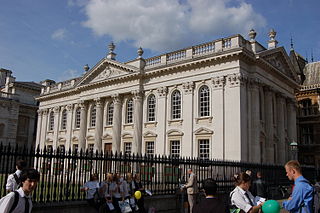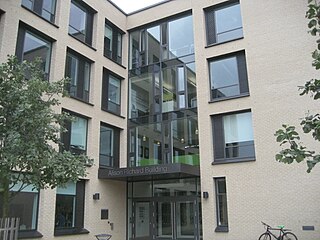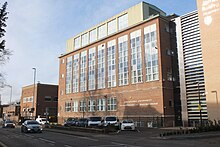
Pembroke College is a constituent college of the University of Cambridge, England. The college is the third-oldest college of the university and has over 700 students and fellows. It is one of the university's larger colleges, with buildings from almost every century since its founding, as well as extensive gardens. Its members are termed "Valencians". The college's current master is Chris Smith, Baron Smith of Finsbury.

Peterhouse is the oldest constituent college of the University of Cambridge in England, founded in 1284 by Hugh de Balsham, Bishop of Ely. Peterhouse has around 300 undergraduate and 175 graduate students, and 54 fellows. It is quite often erroneously referred to as Peterhouse College: the correct name is simply Peterhouse.

A Tripos is an academic examination that originated at the University of Cambridge in Cambridge, England. They include any of several examinations required to qualify an undergraduate student for a bachelor's degree or the courses taken by a student to prepare for these. Undergraduate students studying mathematics, for instance, ultimately take the Mathematical Tripos, and students of English literature take the English Tripos.

John Hopkinson, FRS, was a British physicist, electrical engineer, Fellow of the Royal Society and President of the IEE twice in 1890 and 1896. He invented the three-wire (three-phase) system for the distribution of electrical power, for which he was granted a patent in 1882. He also worked in many areas of electromagnetism and electrostatics, and in 1890 was appointed professor of electrical engineering at King's College London, where he was also director of the Siemens Laboratory.

The Institute of Astronomy (IoA) is the largest of the three astronomy departments in the University of Cambridge, and one of the largest astronomy sites in the United Kingdom. Around 180 academics, postdocs, visitors and assistant staff work at the department.

The Royal College of Science and Technology was a higher education college that existed in Glasgow, Scotland between 1887 and 1964. Tracing its history back to the Andersonian Institute, it is the direct predecessor institution of the University of Strathclyde. Its main building on George Street now serves as one of the major academic and administration buildings of the University of Strathclyde.

The New Museums Site is a major site of the University of Cambridge, located on Pembroke Street and Free School Lane, sandwiched between Corpus Christi College, Pembroke College and Lion Yard. Its postcode is CB2 3QH. The smaller and older of two university city-centre science sites, the New Museums Site houses many of the university's science departments and lecture theatres, as well as two museums.
Sir William Rede Hawthorne CBE, FRS, FREng, FIMECHE, FRAES, was a British professor of engineering who worked on the development of the jet engine. Bragg-Hawthorne equation is named after him.
Sir Bennett Melvill Jones, was Francis Mond Professor of Aeronautical Engineering at the University of Cambridge from 1919 to 1952. He demonstrated the importance of streamlining in aircraft design. It had been known since the time of Aristotle, that a moving body passing through air or another fluid encounters resistance, but Jones developed the ideas of Louis Charles Breguet into a refined theory to demonstrate emphatically the importance of drag to the performance of aircraft.

The Department of Chemical Engineering and Biotechnology (CEB) is one of the teaching and research departments at the University of Cambridge. The department trains undergraduate students and conducts original research at the interfaces between engineering, chemistry, biology and physics. It conducts research in collaboration with industrial partners. Its research programmes encompass sustainable reaction engineering, chemical product and process design, healthcare, measurement, and materials science. It conducts biotechnology research with chemical engineering at the science-engineering interface.

Sir Charles Edward Inglis, was a British civil engineer. The son of a medical doctor, he was educated at Cheltenham College and won a scholarship to King's College, Cambridge, where he would later forge a career as an academic. Inglis spent a two-year period with the engineering firm run by John Wolfe-Barry before he returned to King's College as a lecturer. Working with Professors James Alfred Ewing and Bertram Hopkinson, he made several important studies into the effects of vibration on structures and defects on the strength of plate steel.

The Faculty of Human, Social, and Political Science at the University of Cambridge was created in 2011 out of a merger of the Faculty of Archaeology and Anthropology and the Faculty of Politics, Psychology, Sociology and International Studies. According to the Cambridge HSPS website: graduates pursue careers in "research, the Civil Service, journalism, management consultancy, museums, conservation and heritage management, national and international NGOs and development agencies, the Law, teaching, publishing, health management, and public relations."

The Whittle Laboratory works on reducing the climate impact of aircraft and power generation. It is located at the West Cambridge site in Cambridge, UK. It is a part of the Department of Engineering, at the University of Cambridge. The Whittle Lab has its origins in Sir Frank Whittle and a number of his original team, from Cambridge, and who in 1937 invented the jet engine. In opening the Lab in 1973 the aim was to develop the technology which would underpin the emerging age of mass air travel. The Whittle Laboratory today is one of the world's leading jet engine and power generation research laboratories. It has partnered with Rolls-Royce, Mitsubishi Heavy Industries, and Siemens for over 50 years; with Dyson for 10 years; and in the last few years with many of the new entrants into the aviation sector. The Whittle Laboratory has successfully translated hundreds of primary research ideas into industrial products and its research has been awarded the American Society of Mechanical Engineers highest honour, the ‘Gas Turbine Award’ 15 times, more than any other institution or company. The current focus of the Laboratory is to accelerate the decarbonisation of flight and energy.

The University of Cambridge is a public collegiate research university in Cambridge, England. Founded in 1209, the University of Cambridge is the world's third-oldest university in continuous operation. The university's founding followed the arrival of scholars who left the University of Oxford for Cambridge after a dispute with local townspeople. The two ancient English universities, although sometimes described as rivals, share many common features and are often jointly referred to as Oxbridge.
The Department of History and Philosophy of Science (HPS), of the University of Cambridge is the largest department of history and philosophy of science in the United Kingdom. A majority of its submissions received maximum ratings of 4* and 3* in the 2014 REF. Located in the historic buildings of the Old Physical Chemistry Laboratories on Free School Lane, Cambridge, the department teaches undergraduate courses towards the Cambridge Tripos and graduate courses including a taught Masters and PhD supervision in the field of HPS. The department shares its premises with the Whipple Museum and Whipple Library which provide important resources for its teaching and research.

Sir John Harold Horlock FRS FREng was a British professor of mechanical engineering, and was vice-chancellor of both the Open University and the University of Salford, as well as vice-president of the Royal Society. In 1977, he was elected a fellow of the Royal Academy of Engineering
The Department of Architecture is part of the Faculty of Architecture and History of Art in the University of Cambridge. Both Departments are housed in Scroope Terrace on Trumpington Street, Cambridge.

The Faculty of Classics is one of the constituent departments of the University of Cambridge. It teaches the Classical Tripos. The Faculty is divided into five caucuses ; literature, ancient philosophy, ancient history, Classical art and archaeology, linguistics, and interdisciplinary studies.

The Faculty of History is one of the constituent departments of the University of Cambridge.
The Faculty of Economics is one of the constituent departments of the University of Cambridge. It is composed of five research groups, in macroeconomics, microeconomic theory, economic history, econometrics, and empirical microeconomics. It is located in the Sidgwick Site in Cambridge, has been host to many distinguished economists, and is regarded as the birthplace of macroeconomics. 19 students or members of the faculty have won the Nobel Memorial Prize in Economic Sciences.

















